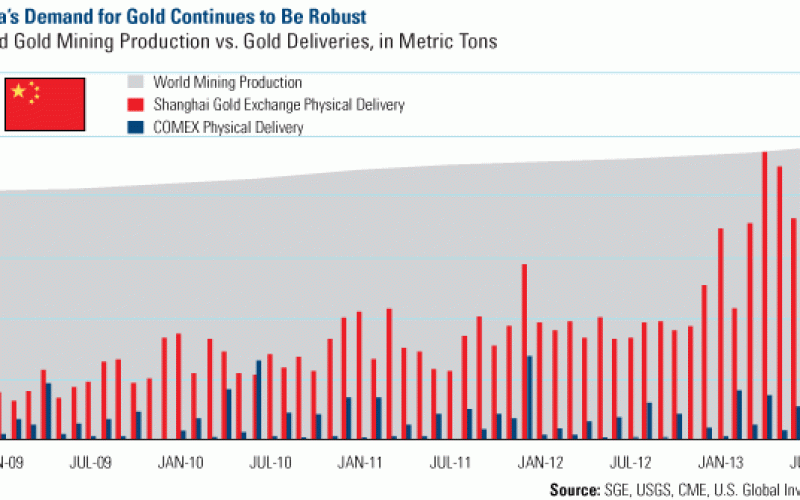Gold Market Radar (October 14, 2013)
For the week, spot gold closed at $1,272.18, down $38.62 per ounce, or 2.95 percent. Gold stocks, as measured by the NYSE Arca Gold Miners Index, declined 4.50 percent. The U.S. Trade-Weighted Dollar Index rose 0.41 percent for the week.
Strengths
- Recently there have been predictions that imports of gold into China would slow down and that current levels cannot be sustained. In August, import figures declined minimally for the prior month but still remained above the sizeable volume of 100 tons. China remains on track to comfortably exceed 1,000 tons of known net gold imports for the year. By “known” we mean those being imported legally through Hong Kong, the only entry point where volumes are reported. There are plenty of other major ports of entry for trade into China; not least Shanghai, where the Shanghai Gold Exchange and the Shanghai Futures Exchange have become the world’s most active physical gold exchange markets, and the second most active gold futures market, in just a few short years. The amount of physical gold traded in Shanghai gets close to total global mine production at times.
- This year central banks will add as much as 350 tons of gold, valued at about $15 billion, estimates the London-based World Gold Council. Similarly, European central banks sold 5.1 metric tons of gold this year, the lowest on record. But what about the U.S. Treasury? In a recent document, the Treasury admitted to considering a range of options with respect to how it would operate if the U.S. had exhausted its borrowing authority. In conclusion, the Treasury considered asset sales while it outright rejected the option of selling the nation’s gold to meet payment obligations. The Treasury reasons that selling gold would undercut confidence in the U.S. both here and abroad, and would be destabilizing to the world financial system as well. In other words, according to the official position of the U.S. Treasury, the promises and commitments of the government, and its “full faith and credit,” are actually worth less than gold.
- This week, Rio Alto Mining announced third-quarter gold production and sales of 59,157 ounces from its La Arena operations in Peru. Production hit a new quarterly record, and came in at a higher grade of 0.58 grams per ton. Full-year guidance for 2013 was reaffirmed. Meanwhile, Kinross Gold Corp. announced the achievement of commercial production at its newest mine on schedule and on budget. The new Dvoinoye gold mine in Russia’s Chukotka Region is a low-cost mine which strongly reflects the company’s focus on maximizing margins and cash flow. At peak production, Dvoinoye is expected to produce between 235,000 to 300,000 gold-equivalent ounces, annually.
Weaknesses
- The National Bank Financial team of mining analysts expects that momentum for producers could remain subdued through year-end, as depressed gold prices could trigger another round of impairment charges in the third quarter. This is in addition to possible reserve write-downs at year end, and to significant revisions to 2014 mine plans as companies revisit cut-off grade strategies to navigate the current, low gold price environment. They go on to add that now that newest, capital-intensive projects have been shelved, the quality over quantity focus has extended decidedly to operating costs as companies adopt strategies to provide more breathing room and/or to restore more sustainable margins. This leads to the conclusion that there is potential for another round of corporate G&A cuts coming before year-end.
- Detour Gold Corp. reported its quarterly production number, coming in below expectations at 75,000 ounces. Grades were also lower at 0.72 grams per ton, compared to expectations of 0.83 grams per ton. The decline in grades is partially attributed to throughput coming in from low grade stockpiles. Similarly, Allied Nevada Gold Corp. reported quarterly production of 52,200 ounces from its Hycroft mine in Nevada. However, concerns remain over the feasibility of the large mill initiative at current gold and silver prices. The company will have an estimated year-end working capital position of around $58 million, according to analyst Michael Gray of Macquarie. This financial position poses significant risks considering the $580 million of debt, and the minimum of around $11 million quarterly interest payments.
- Pretium Resources Inc. had its biggest drop ever after a company hired to evaluate the bulk sample from its high-grade project unexpectedly quit the project. Strathcona Mineral Services Ltd., which was hired for an independent assessment of a 10,000 metric-ton ore sample, resigned, citing a disagreement with Snowden Mining Industry Consultants Ltd., another company hired to examine the ore. CEO Robert Quartermai was quoted as saying there was a disagreement in the model used to test the sample. Regardless, the program will continue with an official bulk sample report expected in the fourth quarter. Pretium also took the opportunity to release additional results from exploration drilling in the Valley of the Kings, including seven intersections grading greater than 1,000 grams per ton of gold.
Opportunities
- The nomination of Janet Yellen as the new Federal Reserve Chairmanship could mean more dovish Fed policy. Jim O’Neill, the retiring Goldman Sachs Asset Management Chairman who first coined the “BRIC” countries term, believes Yellen represents the dovish wing of Bernanke. In fact, he says she “out-doves” Bernanke. The implications for emerging markets are imminent according to O’Neill, given the more accommodative nature of the Fed under Yellen’s leadership. A more accommodative Fed policy will likely be accompanied by a weakening dollar, which could bode well for gold prices going forward. With this in mind, consider Goldman Sachs’ second-quarter regulatory disclosure, which showed the addition of a significant portion of gold to its holdings. However, the Bank’s commodities research analysts issued a recommendation to sell gold into 2014. Upon such a statement by the analysts, Seeking Alpha’s Real Estate contributor Dave Kranzler asked, “Which side of Goldman Sachs is right about gold? As an investor, do you follow the guy selling research or do you follow the money?”
- The Moscow Exchange will introduce trading of gold and silver as early as this month, as part of plans to make metals more accessible to smaller banks by reducing transaction costs, Bloomberg reports. The exchange will set minimum trades starting at 10 grams of gold and 100 grams of silver, while platinum and palladium contracts will start trading in the first half of 2014. The Moscow Exchange is following the path of the Shanghai Gold Exchange by listing precious metals. It is doing so in order to add liquidity, broaden the range of instruments available for hedging, but also to increase the availability of precious metals to non-traditional market participants. We believe this market should be able to build on the experience of the Shanghai Exchange, and will offer a greater degree of actual physical trading volume, helping to increase the transparency of gold demand and supply factors.
- An article in Canada’s National Post this week discussed mergers and acquisitions within the mining sector, saying activity is brewing under the surface. According to the daily newspaper, M&A activity was red hot in the mining space during 2010 and 2011 before slowing to a crawl over the past 18 months. The reasons behind this behavior are numerous and include volatile commodity prices, plunging stock valuations, a challenging financing environment, the expectations of asset write-downs, and the resultant CEO firings. According to PricewaterhouseCoopers, M&A activity in the mining sector during the first half of 2013 was down 31 percent from the same period a year prior. The second half began timidly as well. However, in the last six weeks the volume of activity has increased noticeably. The fact that stock prices across the sector have been decimated is finally getting major producers serious about acquisitions again. Many on the street believe that the next wave of M&A is underway, even if everyone isn’t quite aware of it yet.
Threats
- The belief that the U.S. will extend the recovery soon after lawmakers resolve the stalemate, led Goldman Sachs’ head of commodity strategy to recommend selling gold for the next twelve months, with a target price of $1,150 per ounce. However, as GoldCore director Mark O’Byrne reminds us, Goldman’s reputation in forecasting gold prices is less than stellar. The bank, among much fanfare and media attention, recommended to its clients to sell gold into 2008 and named the recommendation as one of its top ten tips. Gold rose more than 12 percent from the time of that recommendation and into December 2008. The closing price for 2008 was nearly 20 percent higher than Goldman’s price forecast, costing its clients and the public a lot of money. Perhaps that is why Kevin Norrish, head of commodity research at Barclays, issued a note of caution against selling gold despite any weakness.
- The Reserve Bank of India (RBI) appears to be moving ahead with its plan to get current gold holders to place the metal on deposit for the bank, developed to reduce import demand. Under the program, gold owners would receive interest and have the security of a guarantee backed by the central bank, while the RBI would lend the gold to the jewelry manufacturing sector, thereby reducing demand for imports, says Credit Suisse. What is worrisome here is that at least one western bank is in talks with one of the leading jewelry federations about the creation of a similar deposit scheme. This type of mechanism could result in the creation of an unregulated paper gold trading market, subject to manipulation.
- We recently learned that 95 percent of transactions in the futures and options markets are terminated before they reach the date on which gold has to be delivered. This means that only one out of every 20 transactions involves physical delivery, and 19 are simply paper gold trades. Our trading desk has observed some odd market activity that we have deemed the “gold flashing” trade, and appears biased toward the paper trading side. For instance, this past Wednesday morning, our traders witnessed a high frequency trader offer 47,000 contracts for sale for only one second, before cancelling 45,000 of them. Naturally, markets react negatively to sudden large offers, sending the markets into a downward spiral.















